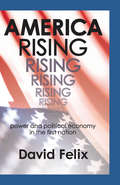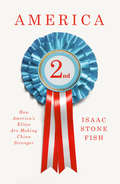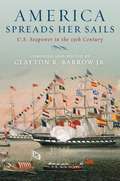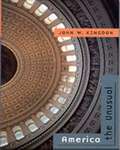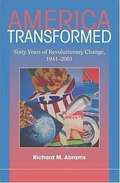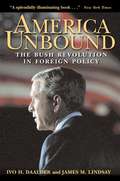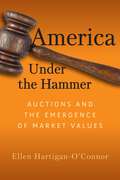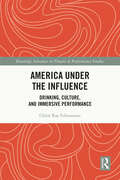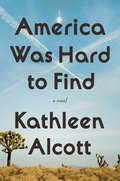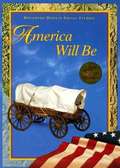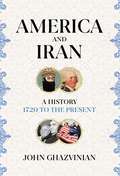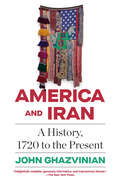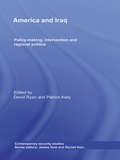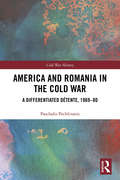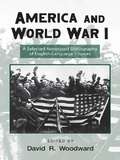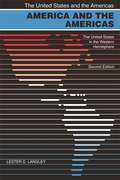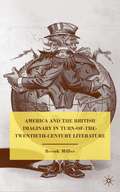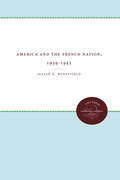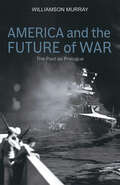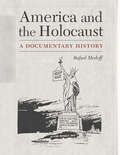- Table View
- List View
America Rising: Power and Political Economy in the First Nation
by David FelixThe United States became a great power in the last quarter of the nineteenth century and a superpower during World War II without quite knowing it. Few Americans fully appreciate the fact today. How many people know that in recent years we have had 250,000 troops in 700 bases around the world? Consider our recent history of military operations in the Caribbean, East Asia, the Far East, Middle East, Southeast Asia, Africa, and the Balkans. In America Rising, David Felix attempts to explain how and why America became a superpower by examining the political and economic factors that have driven its ascendence and their relationship throughout history.Felix begins with the dawn of America, showing how America amassed wealth and political power from the start through wars, assertions of economic might, and the creation of a cultural and philosophical base. The nation began with a political order, derived from our British origins, which enabled our pragmatic culture to take advantage of the vast wealth of a near-virgin continent. Political and economic freedom were paired, authority yielding to both freedoms. Our farmers and businessmen were dreamers, manufacturing realities out of those dreams. Felix's account then makes a point of neoclassical economics as an anvil on which to hammer out a sharper sense of the content of our existence.This book, which demonstrates the author's zest for historical analysis and great story-telling ability, points to the central fact of a rising America--the intensely energizing interaction between polity and economy. The United States is the greatest power in world history, but the rise of another great power, China, is beginning to be increasingly apparent. One trusts that, drawing upon its deep resources, America will remember its history and traditions and continue as a superpower.
America Second: How America's Elites Are Making China Stronger
by Isaac Stone FishA timely, provocative exposé of American political and business leadership&’s deep ties to China: a network of people who believe they are doing the right thing—at a profound and often hidden cost to U.S. interests.The past few years have seen relations between China and the United States shift, from enthusiastic economic partners, to wary frenemies, to open rivals. Americans have been slow to wake up to the challenges posed by the Chinese Communist Party. Why did this happen? And what can we do about it? In America Second, Isaac Stone Fish traces the evolution of the Party&’s influence in America. He shows how America&’s leaders initially welcomed China&’s entry into the U.S. economy, believing that trade and engagement would lead to a more democratic China. And he explains how—although this belief has proved misguided--many of our businesspeople and politicians have become too dependent on China to challenge it. America Second exposes a deep network of Beijing&’s influence in America, built quietly over the years through prominent figures like former secretaries of state Henry Kissinger and Madeleine Albright, Disney chairman Bob Iger, and members of the Bush family. And it shows how to fight that influence–without being paranoid, xenophobic, or racist. This is an authoritative and important story of corruption and good intentions gone wrong, with serious implications not only for the future of the United States, but for the world at large.
America Spreads Her Sails
by Clayton R. BarrowIn this new paperback edition of America Spreads Her Sails, fourteen writers and historians demonstrate how American men and goods in American-made ships moved out over Alfred Thayer Mahan’s "broad common,” the sea, to extend the country’s commerce, power, political influence, and culture. Capt. Thomas ap Catesby Jones, Lt. John "Mad Jack” Percival, and Comm. Matthew Calbraith Perry are among some of the colorful names that many will recognize. They are all gone now, these strong men and their stout ships, who carried their country’s colors up to the Northern Lights, down to the Antarctic’s stillness, over the cutting coral, across the Roaring Forties, and into the great ports and the backwaters of the world. The results of their adventures, however, are not forgotten, but instead set the stage for America to indisputably become the dominant world power of the past century.
America The Unusual
by John W. KingdonKingdon explores how the American polity is different from that of other countries - particularly other Western democracies - examining just how this uniqueness came about. It invites both introductory and advanced students to appreciate the roots and limits of American exceptionalism, and to recognize the profound importance of current debates over the government's role in our everyday lives.
America Transformed: Sixty Years of Revolutionary Change, 1941-2001
by Richard M. AbramsDuring the 35 years after America's entry into the Second World War, the country experienced another remarkably rapid and dramatic transformation. Indeed, the manifold changes in areas of American life - ranging from the country's international role and its business structure to Americans' racial and gender relations, their sexual practices, and their regard for privacy - were nothing less than revolutionary. Abrams has drawn on a wealth of mostly published sources on such diverse subjects to offer a fresh, thematically arranged, and often controversial account of that transformation and of the conservative backlash that followed.
America Unbound: The Bush Revolution in Foreign Policy
by Ivo H. Daalder James M. LindsayAnalysis of George W. Bush's foreign policy, specifically from the start of his administration to mid 2003.
America Under the Hammer: Auctions and the Emergence of Market Values (Early American Studies)
by Ellen Hartigan-O'ConnorReveals how, through auctions, early Americans learned capitalismAs the first book-length study of auctions in early America, America Under the Hammer follows this ubiquitous but largely overlooked institution to reveal how, across the eighteenth and early nineteenth centuries, price became an accepted expression of value. From the earliest days of colonial conquest, auctions put Native land and human beings up for bidding alongside material goods, normalizing new economic practices that turned social relations into economic calculations and eventually became recognizable as nineteenth-century American capitalism.Starting in the eighteenth century, neighbors collectively turned speculative value into economic “facts” in the form of concrete prices for specific items, thereby establishing ideas about fair exchange in their communities. This consensus soon fractured: during the Revolutionary War, state governments auctioned loyalist property, weaponizing local group participation in pricing and distribution to punish political enemies. By the early nineteenth century, suspicion that auction outcomes were determined by manipulative auctioneers prompted politicians and satirists to police the boundaries of what counted as economic exchange and for whose benefit the economy operated. Women at auctions—as commodities, bidders, or beneficiaries—became a focal point for gendering economic value itself. By the 1830s, as abolitionists attacked the public sale of enslaved men, women, and children, auctions had enshrined a set of economic ideas—that any entity could be coded as property and priced through competition—that have become commonsense understandings all too seldom challenged.In contrast to histories focused on banks, currencies, or plantations, America Under the Hammer highlights an institution that integrated market, community, and household in ways that put gender, race, and social bonds at the center of ideas about economic worth. Women and men, enslaved and free, are active participants in this story rather than bystanders, and their labor, judgments, and bodies define the resulting contours of the American economy.
America Under the Influence: Drinking, Culture, and Immersive Performance (Routledge Advances in Theatre & Performance Studies)
by Chloë Rae EdmonsonIn this book, Chloë Rae Edmonson analyzes performance sites from throughout U.S. history to reveal the material ways that drinking culture is performative, immersive performance is intoxicating, and how alcohol shapes performance space. Combining archival research with first-hand accounts of immersive spaces, this study demonstrates how social drinking and performance in themed spaces often collude to reify power dynamics latent to mainstream American culture, such as patriarchal values, racial and wealth inequality, and labor exploitation. Yet there are also examples of how performers, designers, and consumers creatively subvert such dominant attitudes in pursuit of their own creative expression and fulfilment.Part one examines historic bars and clubs that are immersive by design, while part two explores immersive theatre productions from the 1980s to today. At the heart of all these American examples, of course, is alcohol, its associated cultures of immersive consumption, and the wide range of influence it can have on the bodies and minds of participants. In addition to its pop cultural appeal, this study will be relevant to scholars and university students interested in immersive theatre and performance, drinking culture, and American Studies.
America Viduthalai Por
by Pa. RaghavanThe book gives a visual effect while reading the text of America’s War of Independence. It unfolds what happened between the year 1783 when the war ended and 1789 when George Washington was sworn in as the first President of the U.S. which may be new to the readers.
America Was Hard to Find: A Novel
by Kathleen AlcottIn the wake of an affair, the lives of an astronaut and a radical are forever altered by the political fault lines of the 1960s, setting off a series of events ricocheting from anti-Vietnam activism to the Apollo program to the AIDS crisis, in this sprawling multigenerational novelEcuador, 1969: An American expatriate, Fay Fern, sits in the corner of a restaurant, she and her young son Wright turned away from the television where Vincent Kahn becomes the first man to walk on the moon.Years earlier, Fay and Vincent meet at a pilots’ bar in the Mojave Desert. Both seemed poised for reinvention—the married test pilot, Vincent, as an astronaut; the spurned child of privilege, Fay, as an activist. Their casual affair ends quickly, but its consequences linger.Though their lives split, their senses of purpose deepen in tandem, each becoming heroes to different sides of the political spectrum of the 1960s and 70s: Vincent an icon with no plan beyond the mission for which he has single-mindedly trained, Fay a leader of a violent leftist group whose anti-Vietnam actions make her one of the FBI’s most wanted. With her last public appearance, a demonstration that frames the Apollo program as a vehicle for distracting the American public from its country’s atrocities, Fay leaves Wright to contend with her legacy, his own growing apathy, and the misdeeds of both his mother and his country.An immense, vivid reimagining of the Cold War era, America Was Hard to Find traces the fallout of the cultural revolution that divided the country and explores the meaning of individual lives in times of upheaval. It also confirms Kathleen Alcott’s reputation as a fearless and vital voice in fiction.
America Will Be
by Gary B. Nash J. Jorge Klor de Alva Jacqueline M. Cordova Beverly J. ArmentoSocial studies textbook.
America Yesterday and Today
by Carol Berkin Joe Bertram Frantz Joan E. SchreiberSurveys the history of the United States from its first people through the European settlements and changes as a nation up to the present. Includes a unit on current conditions in neighboring countries in North, Central, and South America.
America and Iran: A History, 1720 to the Present
by John GhazvinianIn recent times, the United States and Iran have seemed closer to war than peace, but that is not where their story began. When America was in its infancy, Thomas Jefferson and John Quincy Adams turned to the history of the Persian Empire as they looked for guidance on how to run their new country. And in the following century, Iranian newspapers heralded America as an ideal that their own government might someday emulate. How, then, did the two nations become the adversaries that they are today? In this rich, fascinating history, John Ghazvinian traces the complex story of America and Iran over three centuries. Drawing on years of research conducted in both countries – including access to Iranian government archives rarely available to Western scholars – he leads us through the four seasons of US-Iranian relations: from the spring of mutual fascination, where Iran, sick of duplicitous Britain and Russia interfering in its affairs, sought a relationship with the United States, to the long, dark winter of hatred that we are yet to see end. A revealing account, America and Iran lays bare when, where and how it all went wrong – and why it didn&’t have to be this way.
America and Iran: A History, 1720 to the Present
by John GhazvinianAn important, urgently needed book--a hugely ambitious, illuminating portrait of the two-centuries-long entwined histories of Iran and America, and the first book to examine, in all its aspects, the rich and fraught relations between these two powers--once allies, now adversaries. By an admired historian and the author of Untapped: The Scramble for Africa's Oil ("he would do Graham Greene proud"--Kirkus Reviews).In this rich, fascinating history, John Ghazvinian traces the complex story of the relations of these two powers back to the Persian Empire of the eighteenth century--the subject of great admiration of Thomas Jefferson and John Quincy Adams--and an America seen by Iranians as an ideal to emulate for their own government.Drawing on years of archival research both in the United States and Iran--including access to Iranian government archives rarely available to Western scholars--the Iranian-born, Oxford-educated historian leads us through the four seasons of U.S.-Iran relations: the "spring" of mutual fascination; the "summer" of early interactions; the "autumn" of close strategic ties; and the long, dark "winter" of mutual hatred.Ghazvinian, with grasp and a storyteller's ability, makes clear where, how, and when it all went wrong. And shows why two countries that once had such heartfelt admiration for each other became such committed enemies; showing us, as well, how it didn't have to turn out this way.
America and Iraq: Policy-making, Intervention and Regional Politics (Contemporary Security Studies)
by David Ryan Patrick KielyThis edited volume provides an overview on US involvement in Iraq from the 1958 Iraqi coup to the present-day, offering a deeper context to the current conflict. Using a range of innovative methods to interrogate US foreign policy, ideology and culture, the book provides a broad set of reflections on past, present and future implications of US-Iraqi relations, and especially the strategic implications for US policy-making. In doing so, it examines several key aspects of relationship such as: the 1958 Iraqi Revolution; the impact of the 1967 Arab-Israeli War; the impact of the Nixon Doctrine on the regional balance of power; US attempts at rapprochement during the 1980s; the 1990-91 Gulf War; and, finally, sanctions and inspections. Analysis of the contemporary Iraq crisis sets US plans against the ‘reality’ they faced in the country, and explores both attempts to bring security to Iraq, and the implications of failure.
America and Romania in the Cold War: A Differentiated Détente, 1969-80 (Cold War History)
by Paschalis PechlivanisThis book examines the US foreign policy of differentiation towards the socialist regimes of Eastern Europe as it was implemented by various administrations towards Ceausescu’s Romania from 1969 to 1980. Drawing from multi-archival research from both US and Romanian sources, this is the first comprehensive analysis of differentiation and shows that Washington’s Eastern European policy in the 1970s was more nuanced than the common East vs. West narrative suggests. By examining systemic Cold War factors such as the rise of détente between the two superpowers and the role of agency, the study deals with the dynamics that shaped the evolution of American-Romanian relations after Bucharest’s opening towards the West, and the subsequent embrace of this initiative by Washington as an instrument to undermine the unity of the Soviet bloc. Furthermore, it revises interpretations about Carter’s celebrated human rights policy based on the Romanian case, pointing towards a remarkable continuity between the three administrations under examination (Nixon, Ford and Carter). By doing so, this study contributes to the field by highlighting a largely neglected aspect of US foreign policy and uncovers the subtleties of Washington’s relations with one of the most vigorous actors of the Eastern European bloc. This book will be of much interest to students of Cold War Studies, US foreign policy, Eastern European politics and International Relations in general.
America and Vietnam: The Elephant and the Tiger
by Albert MarrinExamines the political history, military events, social impact, and long-term effects of the Vietnam War.
America and World War I: A Selected Annotated Bibliography of English-Language Sources (Routledge Research Guides to American Military Studies)
by David WoodwardAmerica and World War I, the first volume in the new Routledge Research Guides to American Military Studies series, provides a concise, annotated guide to the vast amount of resources available on the Great War. With over 2,000 entries selected from a wide variety of publications, manuscript collections, databases, and online resources, this volume will be an invaluable research tool for students, scholars, and military history buffs alike. The wide range of topics covered include war films and literature, to civil-military relations, to women and war. Routledge Research Guides to American Military Studies will include concise, easy-to-use bibliographic volumes on different American military campaigns throughout history, as well as tackling timely subjects such as women in the military and terrorism.
America and the Americas: The United States in the Western Hemisphere (2nd edition)
by Lester D. LangleyIn this completely revised and updated edition of America and the Americas, Lester D. Langley covers the long period from the colonial era into the twenty-first century, providing an interpretive introduction to the history of U. S. relations with Latin America, the Caribbean, and Canada. Langley draws on the other books in the series to provide a more richly detailed and informed account of the role and place of the United States in the hemisphere. In the process, he explains how the United States, in appropriating the values and symbolism identified with "America," has attained a special place in the minds and estimation of other hemispheric peoples. Discussing the formal structures and diplomatic postures underlying U. S. policy making, Langley examines the political, economic, and cultural currents that often have frustrated inter-American progress and accord.
America and the British Imaginary in Turn-of-the-Twentieth-Century Literature
by Brook MillerIn an innovative reading of fin-de-siecle cultural texts, Miller argues that British representations of America, Americans, and Anglo-American relations at the turn of the twentieth century provided an important forum for cultural distinction.
America and the French Nation, 1939-1945
by Julian G. HurstfieldHurstfield analyzes American responses--diplomatic, military, intellectual, and popular--to the plight of the French nation during World War II, as the constitution of the Third Republic was suspended, Petain ruled in Vichy, the Germans administered Occupied France, DeGaulle organized the Free French movement, and an internal French resistance slowly gathered strength. Interweaving diplomatic and intellectual history, the author combines analysis with a sensitive account of American currents of opinion.Originally published in 1986.A UNC Press Enduring Edition -- UNC Press Enduring Editions use the latest in digital technology to make available again books from our distinguished backlist that were previously out of print. These editions are published unaltered from the original, and are presented in affordable paperback formats, bringing readers both historical and cultural value.
America and the Future of War: The Past as Prologue
by Williamson MurrayThroughout the world today there are obvious trouble spots that have the potential to explode into serious conflicts at any time in the immediate or distant future. This study examines what history suggests about the future possibilities and characteristics of war and the place that thinking about conflict deserves in the formation of American strategy in coming decades. The author offers a historical perspective to show that armed conflict between organized political groups has been mankind's constant companion and that America must remain prepared to use its military power to deal with an unstable, uncertain, and fractious world.Williamson Murray shows that while there are aspects of human conflict that will not change no matter what advances in technology or computing power may occur, the character of war appears to be changing at an increasingly rapid pace with scientific advances providing new and more complex weapons, means of production, communications, and sensors, and myriad other inventions, all capable of altering the character of the battle space in unexpected fashions. He explains why the past is crucial to understanding many of the possibilities that lie in wait, as well as for any examination of the course of American strategy and military performance in the future—and warns that the moral and human results of the failure of American politicians and military leaders to recognize the implications of the past are already apparent.
America and the Holocaust: A Documentary History
by Rafael MedoffThe first comprehensive volume to teach about America&’s response to the Holocaust through visual media, America and the Holocaust: A Documentary History explores the complex subject through the lens of one hundred important documents that help illuminate and amplify key episodes and issues. Each chapter pivots on five key documents: two in image form and three in text form. Individual introductions that contextualize the documents are followed by explanatory text, analysis of historical implications, and suggestions for further reading. A concluding state-of-the-field essay documents how scholars have arrived at the presented information. A complementary teacher&’s guide with questions for discussion is available online. The twenty chapters address a broad range of subjects and events, among them America&’s response to Hitler&’s rise, U.S. public opinion about Jews, immigration policy, the Wagner-Rogers bill to save children, American rescuers, news coverage of atrocities, American Jewish and Christian responses to the Holocaust, the campaign for U.S. rescue action, the question of bombing Auschwitz, and liberation. Viewing real documents as a means to understanding core issues will deepen reader involvement with this material. High school and college students as well as general readers of all levels of knowledge will be engaged in understanding this crucial chapter in American history and weighing questions regarding mass atrocities in our own era.
America and the Japanese Miracle
by Aaron ForsbergIn this book, Aaron Forsberg presents an arresting account of Japan's postwar economic resurgence in a world polarized by the Cold War. His fresh interpretation highlights the many connections between Japan's economic revival and changes that occurred in the wider world during the 1950s. Drawing on a wealth of recently released American, British, and Japanese archival records, Forsberg demonstrates that American Cold War strategy and the U.S. commitment to liberal trade played a central role in promoting Japanese economic welfare and in forging the economic relationship between Japan and the United States. The price of economic opportunity and interdependence, however, was a strong undercurrent of mutual frustration, as patterns of conflict and compromise over trade, investment, and relations with China continued to characterize the postwar U.S.-Japanese relationship.Forsberg's emphasis on the dynamic interaction of Cold War strategy, the business environment, and Japanese development challenges "revisionist" interpretations of Japan's success. In exploring the complex origins of the U.S.-led international economy that has outlasted the Cold War, Forsberg refutes the claim that the U.S. government sacrificed American commercial interests in favor of its military partnership with Japan.
America and the Japanese Miracle: The Cold War Context of Japan's Postwar Economic Revival, 1950-1960
by Aaron ForsbergIn this book, Aaron Forsberg presents an arresting account of Japan's postwar economic resurgence in a world polarized by the Cold War. His fresh interpretation highlights the many connections between Japan's economic revival and changes that occurred in the wider world during the 1950s. Drawing on a wealth of recently released American, British, and Japanese archival records, Forsberg demonstrates that American Cold War strategy and the U.S. commitment to liberal trade played a central role in promoting Japanese economic welfare and in forging the economic relationship between Japan and the United States. The price of economic opportunity and interdependence, however, was a strong undercurrent of mutual frustration, as patterns of conflict and compromise over trade, investment, and relations with China continued to characterize the postwar U.S.-Japanese relationship.Forsberg's emphasis on the dynamic interaction of Cold War strategy, the business environment, and Japanese development challenges "revisionist" interpretations of Japan's success. In exploring the complex origins of the U.S.-led international economy that has outlasted the Cold War, Forsberg refutes the claim that the U.S. government sacrificed American commercial interests in favor of its military partnership with Japan.
